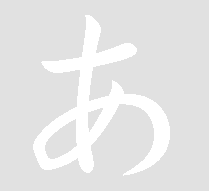 |
||||
 |
||||
|
Chapter2 HIRAGANA Then, around the 8th century a new set of phonetic symbols, called hiragana, was created by simplifying certain kanji which represented sounds which were similar to respective Japanese sounds. This was done by the court ladies who represented a learned class of the time. Presently, for most of nouns, each of which represents an independent notion and does not have inflected forms, kanji are predominantly used. Also, for Adjectival and Verbal predicates, the core part (root) of the word is predominantly written in kanji, but their inflected parts are written in hiragana. Also, instrumental parts of the Japanese language, like sentence-particles, clause-particles and phrase-particles, are always written in hiragana. Hiragana is also used to indicate how to read kanji, as there can be a number of ways of reading the same kanji as you will later learn. Hiragana and katakana have complete correspondence like capital and small letters in Roman alphabet. Some of them look alike, too, as they are derived from the same kanji. |
|||||||||||||||||||||||||||||||||||||||||||||||||||||||||||||||||||||||||||||||||||||||||||||||||||||||||||||||||||||||||||||||||||||||||||||||||||||||||

|